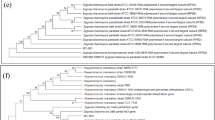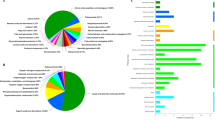Abstract
Tobacco mildew and tobacco-specific nitrosamines (TSNAs) affect the quality of tobacco products during fermentation. Microbes are thought to play key roles in the development of specific properties of fermented tobacco; however, little is known about the bacteria involved in the fermentation process. This study aims to identify key microbes related to mildew and TSNA formation. Tobacco was fermented at 25 °C, 35 °C, and 45 °C for 2, 4, and 6 weeks, with unfermented samples used as controls. Our preliminary exploration found that TSNAs content elevated with the increase of temperature and period, and mildew was easy to occur at low temperature with short period. Hence, samples were divided into three groups: the temperature gradient group (25 °C, 35 °C, and 45 °C for 6 weeks); the low-temperature group (control, 25 °C for 2, 4, and 6 weeks); and the high-temperature group (control, 45 °C for 2, 4, and 6 weeks). After collecting fermented tobacco leaves, 16S rRNA gene sequencing was used to explore the structure and dynamic changes of bacterial community during fermentation. Methylobacterium and Deinococcus were shared between the temperature gradient and high-temperature groups and showed a linear downward trend; these might play a role in the production of TSNAs. Massilia, Ruminiclostridium, and Cellulosilyticum species increased with prolonged fermentation time in the low-temperature group; this might be associated with tobacco mildew. In summary, the microbial diversity of fermented tobacco was explored under different conditions. These findings might provide data and material support to improve the quality of fermented tobacco products; however, further omics based studies are warranted to analysis the gene and protein expression patter in the identified bacteria.





Similar content being viewed by others
Data Availability
Data used to support the findings of this study are available from the corresponding author upon request.
References
Li Z (2022) Modeling pesticide residues in tobacco leaves for improving life cycle inventory analysis of pesticides in the cigarette industry. Sci Total Environ 845:157267. https://doi.org/10.1016/j.scitotenv.2022.157267
Burki TK (2021) Who releases latest report on the global tobacco epidemic. Lancet Oncol 22(9):1217. https://doi.org/10.1016/S1470-2045(21)00464-2
Yang Y, Peng Q, Ou M, Wu Y, Jing F (2018) Research progress in tobacco fermentation. J Biosci Med 06(6):105–114
Li X, Li M, Wan D, Li L, Chen D, Ding S et al (2019) Role of microorganisms in tobacco fermentation and alcoholization: a review. Microbiol China 46(6):1520–1529
Wang Y (2016) Research progress of microorganism in tobacco fermentation. Sci Res 9:337
Yu J, Li L, Pang T, Ren X, Shao H (2006) Research advancement of tobacco fermentation. J Henan Agric Univ 040(1):108–112
Sun Y (2014) Research progress of microorganism in tobacco fermentation. Mod Agricl Sci Technol 9(12):302–303
Konstantinou E, Fotopoulou F, Drosos A, Dimakopoulou N, Zagoriti Z, Niarchos A et al (2018) Tobacco-specific nitrosamines: a literature review. Food Chem Toxicol 118:198–203
Sarlak S, Lalou C, Amoedo ND, Rossignol R (2020) Metabolic reprogramming by tobacco-specific nitrosamines (TSNAS) in cancer. Semin Cell Dev Biol 98:154–166
Czoli CD, Hammond D (2018) Trends over time in tobacco-specific nitrosamines (TSNAS) in whole tobacco and smoke emissions from cigarettes sold in Canada. Nicotine Tob Res 20(5):649–653. https://doi.org/10.1093/ntr/ntx103
Lu J, Zhang H, Su X, Ma D, Du Y (2014) The influence of different storage conditions on the cured tobacco leaves mildew. J Pure Appl Microbiol 8(3):2135–2139
Zhao W (2004) Study on mold and biological control of stored tobacco leaves in Yunnan province. Chinese Academy of Agricultural Sciences, Beijing, China
Zhu G (2005) Identification, biological characteristics and control of moldy organisms in tobacco silos in Guangxi. Guangxi Zhuang Autonomous Region, China
Chen QL, Li Z, Wang HC, Huang Y, Cai LT, Xie HL, Zhou H (2019) Fungal composition and diversity of tobacco phyllosphere from cured tobacco leaves. Acta Microbiol Sin 59(12):2401–2409
Zhang Q, Geng Z, Li D, Ding Z (2020) Characterization and discrimination of microbial community and co-occurrence patterns in fresh and strong flavor style flue-cured tobacco leaves. MicrobiologyOpen 9(2):e965. https://doi.org/10.1002/mbo3.965
Li J, Zhao Y, Qin Y, Shi H (2020) Influence of microbiota and metabolites on the quality of tobacco during fermentation. BMC Microbiol 20(1):356. https://doi.org/10.1186/s12866-020-02035-8
Yang Q, Xiao M, Lin R, Bao X, Pu Y (2014) Research on improving aging quality of tobacco leave by adding enzyme. Southwest China J Agric Sci 27(04):1746–1750
Wen C, Zhang Q, Zhu P, Hu W, Jia Y, Yang S et al (2023) High throughput screening of key functional strains based on improving tobacco quality and mixed fermentation. Front Bioeng Biotechnol 11:1108766. https://doi.org/10.3389/fbioe.2023.1108766
Chattopadhyay S, Malayil L, Mongodin EF, Sapkota AR (2021) A roadmap from unknowns to knowns: advancing our understanding of the microbiomes of commercially available tobacco products. Appl Microbiol Biotechnol 105(7):2633–2645. https://doi.org/10.1007/s00253-021-11183-4
Zhou W, Liu Y, Zeng D, Yang J, Hu X, Song S et al (2016) Research and application on stacking and fermentation technology of cigar tomato core tobacco leaves. Agric Sci 6(3):8
Yang Z, Zhang Z, Song S, Zhang L, Jia L, Chen X et al (2018) Effects of two different fermentation methods on the chemical composition and sensory quality of sun-cured tobacco leaves. J Anhui Agric Sci 46(6):8–11
Yu M, Jia H, Zhou C, Yang Y, Zhao Y, Yang M et al (2017) Variations in gut microbiota and fecal metabolic phenotype associated with depression by 16S rRNA gene sequencing and LC/MS-based metabolomics. J Pharm Biomed Anal 138:231–239
Rognes T, Flouri T, Nichols B, Quince C, Mahé F (2016) Vsearch: a versatile open source tool for metagenomics. PeerJ 4:e2584
Leng N, Dawson JA, Thomson JA, Ruotti V, Rissman AI, Smits BM et al (2013) EBSeq: an empirical Bayes hierarchical model for inference in RNA-seq experiments. Bioinformatics (Oxford, England) 29(8):1035–1043
Schloss PD (2019) Reintroducing mothur: 10 years later. Appl Environ Microbiol 86(2):e02343-19
Aßhauer KP, Bernd W, Rolf D, Peter M (2015) Tax4Fun: predicting functional profiles from metagenomic 16S rRNA data. Bioinformatics (Oxford, England) 31(17):2882–2884
Wang J, Yang H, Shi H, Zhou J, Bai R, Zhang M et al (2017) Nitrate and nitrite promote formation of tobacco-specific nitrosamines via nitrogen oxides intermediates during postcured storage under warm temperature. J Chem 2017:6135215. https://doi.org/10.1155/2017/6135215
Li L (2022) Analysis of tobacco leaf modulation and fermentation technology. Agric Henan 598(02):25–26
Liu T, Guo S, Wu C, Zhang R, Zhong Q, Shi H et al (2022) Phyllosphere microbial community of cigar tobacco and its corresponding metabolites. Front Microbiol 13:1025881. https://doi.org/10.3389/fmicb.2022.1025881
Zheng T, Zhang Q, Wu Q, Li D, Wu X, Li P et al (2022) Effects of inoculation with acinetobacter on fermentation of cigar tobacco leaves. Front Microbiol 13:911791. https://doi.org/10.3389/fmicb.2022.911791
Wang R, Shi Z, Zhou J, Bai R, Yang H, Ma Y et al (2014) Changes in TSNAS content during tobacco storage and its response to high temperature treatment. Acta Tabacaria Sinica 20(01):48–53
Sun W, Wang J, Xu D, Zhou J, Bai R, Ma Y et al (2016) Relationship between moisture content of burley tobacco leaves and TSNA formation during high temperature storage. Acta Tabacaria Sinica 22(04):38–43
Zhang Y, Gong W, Liu K, Wang G (2007) Degradation of tobacco-specific nitrosamines by denitrifying bacteria. J Zhongkai Univ Agric Eng 1:5–8
Nestor TB, Gentry JS, Riddick MG, Conner BT, Peele DM, Edwards ME (2003) Role of oxides of nitrogen in tobacco-specific nitrosamine formation in flue-cured tobacco. Beiträge Zur Tabakforschung 20(7):467–475
Ochsner AM, Sonntag F, Buchhaupt M, Schrader J, Vorholt JA (2015) Methylobacterium extorquens: methylotrophy and biotechnological applications. Appl Microbiol Biotechnol 99(2):517–534
Chistoserdova L (2017) Application of omics approaches to studying Methylotrophs and Methylotroph comunities. Curr Issues Mol Biol 24:119–142
Ardanov P, Sessitsch A, Häggman H, Kozyrovska N, Pirttilä AM (2012) Methylobacterium-induced endophyte community changes correspond with protection of plants against pathogen attack. PLoS ONE 7(10):e46802
Su C, Gu W, Zhe W, Zhang KQ, Duan Y, Yang J (2011) Diversity and phylogeny of bacteria on Zimbabwe tobacco leaves estimated by 16S rRNA sequence analysis. Appl Microbiol Biotechnol 92(5):1033–1044
Chen E, Zhang M, Su J, Sun Z, Zhu K, Zhou Z et al (2019) Prevention and control of mildew of tobacco leaves by regulating air movement in bulk curing barns. J Hunan Univ Arts Sci (Sci Technol) 31(1):56–59+84
Gao Y, Lou X, Chen E, Zhang B, Zhang Z, Shi J et al (2019) Midrib mildew and rot symptoms of tobacco leaves during flue-curing. Tob Sci Technol 52(07):35–40
Yang E, Cui D, Wang W (2019) Research progress on the genus Massilia. Microbiol China 46(6):1537–1548
Lei L, Xia Z, Liu X, Wei HL (2015) Occurrence and variability of tobacco rhizosphere and phyllosphere bacterial communities associated with nicotine biodegradation. Ann Microbiol 65(1):163–173
Annan FJ, Al-Sinawi B, Humphreys CM, Norman R, Winzer K, Köpke M et al (2019) Engineering of vitamin prototrophy in Clostridium ljungdahlii and Clostridium autoethanogenum. Appl Microbiol Biotechnol 103(11):4633–4648
Varel VH (1989) Reisolation and characterization of Clostridium longisporum, a ruminal sporeforming cellulolytic anaerobe. Arch Microbiol 152(3):209–214
Li S, Shao N, Luo Y, Liu H, Cai S, Dong X (2017) Transcriptome and zymogram analyses reveal a cellobiose-dose related reciprocal regulatory effect on cellulase synthesis in Cellulosilyticum ruminicola H1. Front Microbiol 8:2497
Ravachol J, Borne R, Meynial-Salles I, Soucaille P, Pagès S, Tardif C et al (2015) Combining free and aggregated cellulolytic systems in the cellulosome-producing bacterium Ruminiclostridium cellulolyticum. Biotechnol Biofuels 8:114
Guo L, Ma D, Wang J, Ma L (2019) Research progress based on tobacco mildew. Farm Prod Process 101(4):451–461
Bar-Even A, Noor E, Lewis NE, Milo R (2010) Design and analysis of synthetic carbon fixation pathways. Proc Natl Acad Sci USA 107(19):8889–8894
Peng Q, Yi T (2007) Analysis of tobacco mildew and its control measures. Chin Agric Sci Bull 023(11):146–150
Acknowledgements
None.
Funding
This study was funded by the Key Science and Technology Projects of Sichuan Tobacco Company in 2019 (Grant Number SCYC201915) and the Key Science and Technology Projects of Shanghai Tobacco Group in 2019 (Grant Number 2019110004340244).
Author information
Authors and Affiliations
Contributions
Conception and design of the research: JL, HS; acquisition of data: JW and JZ; analysis and interpretation of data: YZ and HY; statistical analysis: XY; obtaining funding: JW and JZ; drafting the manuscript: JL; revision of the manuscript for important intellectual content: HS. All authors have read and approved the final manuscript.
Corresponding author
Ethics declarations
Conflict of interest
The authors declare that they have no conflict of interest.
Consent for Publication
Not applicable.
Research Involving Human and/or Animals Participants
This article does not contain any studies involving human participants or animals performed by any of the authors.
Additional information
Publisher's Note
Springer Nature remains neutral with regard to jurisdictional claims in published maps and institutional affiliations.
Supplementary Information
Below is the link to the electronic supplementary material.
284_2023_3314_MOESM1_ESM.tif
Supplementary file1 (TIF 645 KB)—Figure S1 Representative chromatograms of NNN, NAT, NAB, and NNK in the fermented tobacco sample. NNN N′-nitrosonornicotine; NAT N′-nitrosoanatabine; NAB N′-nitrosoanabasine; NNK 4-(methylnitrosamino)-1-(3-pyridyl)-1-butanone.
284_2023_3314_MOESM2_ESM.xls
Supplementary file2 (XLS 37 KB)—Table S1 The KEGG pathways enriched by microbes in the temperature gradient group. KEGG, Kyoto Encyclopedia of Genes and Genomes.
Rights and permissions
Springer Nature or its licensor (e.g. a society or other partner) holds exclusive rights to this article under a publishing agreement with the author(s) or other rightsholder(s); author self-archiving of the accepted manuscript version of this article is solely governed by the terms of such publishing agreement and applicable law.
About this article
Cite this article
Li, J., Zhao, Y., Yang, H. et al. Identification of Bacteria Associated with Tobacco Mildew and Tobacco-Specific Nitrosamines During Tobacco Fermentation. Curr Microbiol 80, 218 (2023). https://doi.org/10.1007/s00284-023-03314-z
Received:
Accepted:
Published:
DOI: https://doi.org/10.1007/s00284-023-03314-z




